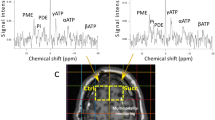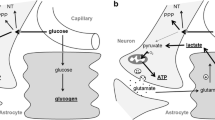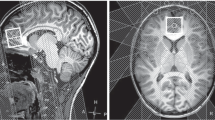The aim of the present work was to use MR spectroscopy to assess the quantitative contents and ratios of different metabolites in the infarct nucleus, ischemic penumbra, and unaltered tissue in the opposite hemisphere in patients in the acute period of ischemic stroke. A total of 72 patients were studied, of whom 37 (the study group) received the antioxidant Mexidol (2-ethyl-6-methyl-3-hydroxypyridine succinate) in addition to basal treatment, while 35 patients received only standard treatment without use of antioxidants. Stroke severity was assessed on the NIHSS scale and functional outcomes on day 30 were evaluated using the Bartel index and modified Rankin scale. MR proton spectroscopy was performed twice: during the first 24 h of disease onset and on day 5. Use of the succinate-containing antioxidant Mexidol (500 mg i.v. for 14 days) during the acute period of ischemic stroke significantly decreased the intracellular lactate (p = 0.002) and inositol contents (p = 0.005) from the levels in the control group, which helped restore the balance between the aerobic and anaerobic mechanisms of oxidation and had favorable influences on the rehabilitation potentials of the patients. A positive correlation was found between the lactate content in the ischemic penumbra zone and values on the NIHSS (r = 0.5786, p = 0.049), along with a negative correlation between the lactate content in the ischemic penumbra zone and the level of functional recovery assessed on the Bartel index (r = –0.6305, p = 0.028), which supports the existence of an interaction between impaired glucose metabolism in hypoxic conditions and the level of injury to nervous tissue.
Similar content being viewed by others
References
V. I. Skvortsova, L. V. Stakhovskaya, Ya. R. Nartsissov, et al., “A randomized double-blind placebo controlled study of the efficacy and safety of Mexidol in the complex treatment of ischemic stroke in the acute period,” Insult, 18, 47–54 (2006).
Zh. Yu. Chefranova, T. A. Makotrova, V. A. Udachin, and E. V. Koledintseva, “Assessment of the efficacy of Mexidol combined with thrombolytic therapy in patients with ischemic stroke,” Zh. Nevrol. Psikhiat., 112, No. 4, 49–52 (2012).
G. I. Izhbul’dina, “Changes in hemostasis and free-radical lipid oxidation during the acute period of ischemic stroke on the background of neuroprotective therapy,” Zh. Nevrol. Psikhiat., 112, No. 3, Iss. 2, 31–37 (2012).
M. Bendszus et al., “Sequential MR imaging and proton MR spectroscopy in patients who underwent recent detoxification for chronic alcoholism: correlation with clinical and neuropsychological data,” Am. J. Neuroradiol., 22, No. 10, 1926–1932 (2001).
H. Kado, H. Kimura, T. Murata, et al., “Depressive psychosis: clinical usefulness of MR spectroscopy data in predicting prognosis,” Radiology, 238, No. 1, 248–255 (2006).
D.-W. Kang, J.-K. Roh, Y.-S. Lee, et al., “Neuronal metabolic changes in the cortical region after subcortical infarction: a proton MR spectroscopy study,” J. Neurol. Neurosurg. Psychiatry, 69, No. 2, 222–227 (2000).
A. C. Pereira, D. E. Saunders, and V. L. Doyle, “Measurement of initial N-actylaspartate concentration by magnetic resonance spectroscopy and initial infarct volume by MRI predicts outcome in patients with middle cerebral artery territory infarction,” Stroke, 30, No. 8, 1577–1582 (1999).
A. E. Podoprigora, I. N. Pronin, and L. M. Fadeeva, “Proton magnetic resonance spectroscopy in neuroradiology,” Med. Viz., No. 4, 86–91 (2000).
A. V. Pozdnyakov, The Role of Proton Magnetic Resonance Spectroscopy in the Diagnosis of Brain Diseases: Auth. Abstr. Dissert. Doct. Med. Sci., St. Petersburg (2001).
F. Nicoli, Y. Lefur, B. Denis, et al., “Metabolic counterpart of decreased apparent diffusion coefficient during hyperacute ischemic stroke: a brain proton magnetic resonance spectroscopic imaging study,” Stroke, 34, 82–87 (2003).
A. L. Coon et al., “Correlation of cerebral metabolites with functional outcome in experimental primate stroke using in vivo 1H magnetic resonance spectroscopy,” Am. J. Neuroradiol., 27, No. 5, 1053–1058 (2006).
Author information
Authors and Affiliations
Corresponding author
Additional information
Translated from Zhurnal Nevrologii i Psikhiatrii imeni S. S. Korsakova, Vol. 113, No. 12, Iss. II, Stroke, pp. 55–60, December, 2013.
Rights and permissions
About this article
Cite this article
Odinak, M.M., Yanishevskii, S.N., Tsygan, N.V. et al. Use of Succinates for Correction of Metabolic Impairments in the Ischemic Penumbra Zone in Stroke Patients. Neurosci Behav Physi 45, 600–604 (2015). https://doi.org/10.1007/s11055-015-0118-4
Published:
Issue Date:
DOI: https://doi.org/10.1007/s11055-015-0118-4




